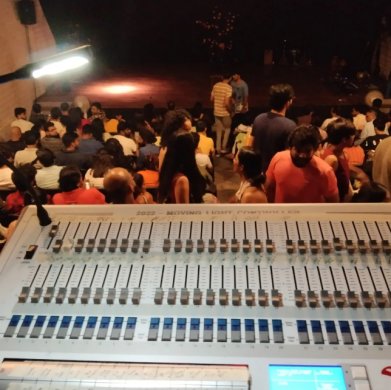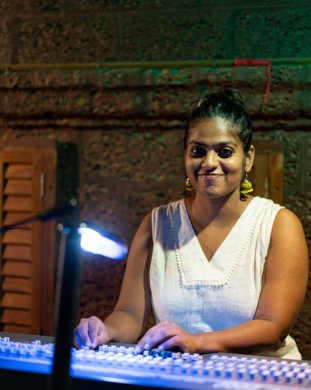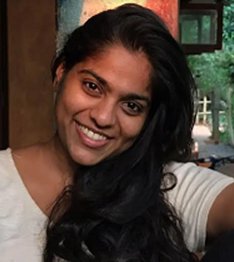
|
 |

|
 |
Actor on the Lights - Parshathy J Nath e-mail: parshathy@gmail.com January 23, 2023 How is it for an actor to work in the lights department and what transforms when one stops looking at the person as an 'operator', but a 'performer'? This is first of a three part series of my experience being mentored for a year at Adishakti Laboratory for Theatre Art Research in Puducherry through the Inlaks Theatre Award scholarship. Lights and performance, two words entwined with each other. Yet so different in their execution. But one cannot do without the other. Lights need a performer's body to find its subject. And the actor needs the lights to reveal herself. So, what happens when an actor turns into a lights performer? When I stepped into Adishakti Laboratory for Theatre Art Research for a year-long mentorship in Theatre Training through the Inlaks Theatre Scholarship award, I never imagined I would be doing the lights. That's a world I had never stepped into in my performance journey. But, little did I know that it will be a transformative journey for me under the mentorship of Vinay Kumar, the artistic director of the institution, by viewing lights and performance in a holistic way.  "Remember, on stage lights are our eyes. What to see and what not to see is decided by our lights. Do not forget that," says a character in Vinay Kumar's latest directorial Bhoomi. Lights accentuates the importance of a scene. It is almost like a zoom in or out. For instance, in a scene where Araja, the ashram girl and her friends chirp about the Vasantholsavam, one friend breaks away from the group and goes behind to stand on a cube, to look for the source of a haunting melody. How does one make sure the audience's gaze is diverted? By giving her a top light as per the commands of the director, who has also designed the lights for the production. Rhythm is an important dimension of an actor's craft. And, so is it that of a lights performer who is just like the actors on stage. I was asked by the director to keep a count of 16 while bringing on the lights. This added a graduality for the lights to merge into the dark canvas like water colours do. It was almost like a slow dance of the lights during the transitions as subtle green hues gave way to bright ambers. And, I remember syncing my breath to that of the actors onstage by almost acting along with them internally and lisping their lines while on the console. This gave me a great command over aligning the rhythm of the lights with that of the actors. I was performing with them on stage; the lights moving on my behalf. Silence enhances a scene by adding immense heaviness to it. Similarly, darkness also did just the same. There is a scene in the play when one of the actors reveals that a co-actor has raped her. There is a giant pause. No one talks. No more guffaws or smart alec jibes. They are even scared to breathe. At that time, I was asked to bring down the general lights slowly and shift to a dull amber light. As the flat general lights gave way to the evening hues of orange, the lights beautifully captured the feeling of an entire collective losing its energy of chatter and disruptions, and sink into the realm of reflection. The scene that followed this was one of the crucial courtroom scenes where the actors perform a surreal role play as lawyers, and a convict and victim. And this entire scene was visualised through a shadow play, by using just four sidelights, two from either side.  By the end of my stint in Adishakti, I had worked on stages of many kinds- from formal prosceniums to parks and festival spaces. There were challenging occasions when we had to work with few dimmers, contrary to the situation at Adishakti. On those occasions, I had to still stick to the director's design in mind and manage. There was no way we could record the combination lights at one stage in Udupi which was held at a park. I had to literally use all my fingers and stand and twirl around to do the lighting as I was working with at least three devices. After the experience of all those venues, by the time I came to the 12th show in Hyderabad in August, I realised that for a lights person, she has to be aligned to the pulse of the play more creatively than anyone else. By then I had seen the evolution of the play over the last one year, and seen how much it had grown and changed. And, since I had the play's journey in mind, my fingers were instinctively responding to the cues. I realised then lights had become a muscle memory for me like speech and movement for an actor who would have been performing for the nth time for the same play. I was very much an actor in that play like everyone else, because now my body was viscerally responding. It encompasses a philosophy Adishakti has always believed in - seeing the person who helms lights also as a performer and not just a technician. Hence, why they call the professional a lights performer and not a lights operator. Moreover, with this experience, I strongly believe an actor must equip herself in all kinds of stage skills such because her craft only gets enhanced when her overall working knowledge of all aspects of the theatre expands. And, lights are cues to an actor just like dialogues, movement and music are. We must listen to stage lights when they hit us; absorb their warmth and let their rays seep into our skin, so that they direct us in ways maybe even language cannot. It could be our most visual bridge to the audience.  Parshathy J Nath is a theatre practitioner and writer. Response * Thank you, Parshathy. Your personal reflections add new angles to meaning-making process. - Sushmita Dey (Jan 23, 2023) Post your comments Pl provide your name and email id along with your comment. All appropriate comments posted with name & email id in the blog will also be featured in the site. |